Chapter 3 Describing Movement in Two Dimensions, 2-D Linear Kinematics
3.4 Projectile Motion
Authors: Paul Peter Urone, Roger Hinrichs
Adapted and revised by: Rob Pryce, Alix Blacklin
Learning Objectives
By the end of this section, you will be able to:
- Identify and explain the properties of a projectile, such as acceleration due to gravity, range, maximum height, and trajectory.
- Determine the location and velocity of a projectile at different points in its trajectory.
- Apply the principle of independence of motion to solve projectile motion problems.
Projectile motion is the motion of an object thrown or projected into the air, subject to only the acceleration of gravity. The object is called a projectile, and its path is called its trajectory. The motion of falling objects, as covered in the previous chapter, is a simple one-dimensional type of projectile motion in which there is no horizontal movement. In this section, we consider two-dimensional projectile motion for which air resistance is negligible. In biomechanics, projectiles come in many forms - they may be objects used in sport, such as footballs, shot put and so on - or in other cases, the human body itself is considered a projectile, such as during jumping or falling. Understanding the principles of projectile motion can provide great insight into many aspects of human movement.
The most important fact to remember here is that motions along the perpendicular are independent and thus can be analyzed separately. This fact was discussed in the introduction to this chapter, where the vertical and horizontal motions were seen to be independent. The key to analyzing two-dimensional projectile motion is to break it into two motions, one along the horizontal axis and the other along the vertical. (This choice of axes is the most sensible, because acceleration due to gravity is vertical—thus, there will be no acceleration along the horizontal axis when air resistance is negligible.) As is customary, we call the horizontal axis the x-axis and the vertical axis the y-axis.
Figure 3.34 illustrates the notation for displacement, where s is defined to be the total displacement and x and y are its components along the horizontal and vertical axes, respectively. The magnitudes of these vectors are s, x, and y. (Note that in the last section we used the notation [latex]\vec{A}[/latex] to represent a vector with components [latex]\vec{A_x}[/latex] and [latex]\vec{A_y}[/latex]. If we continued this format, we would call displacement [latex]\vec{s}[/latex] with components [latex]\vec{s_x}[/latex] and [latex]\vec{s_y}[/latex]. However, to simplify the notation, we will simply represent the component vectors as x and y (i.e. using bolded notation).
Of course, to describe motion we must deal with velocity and acceleration, as well as with displacement. We must find their components along the x- and y-axes, too. We will assume all forces except gravity (such as air resistance and friction, for example) are negligible. The components of acceleration are then very simple: [latex]{a}_{y}=–g=–9.81 m{\text{/s}}^{2}[/latex]. (Note that this definition assumes that the upwards direction is defined as the positive direction. If you arrange the coordinate system instead such that the downwards direction is positive, then acceleration due to gravity takes a positive value.) Because gravity acts only in the vertical direction, the acceleration in the x-direction is zero, [latex]{a}_{x}=0[/latex]. Both accelerations are constant, so the kinematic equations provided earlier can be used.
[latex]x_f = x_i + \bar{v}\Delta t[/latex]
[latex]v_f = v_i + \bar{a}\Delta t[/latex]
[latex]x_f = x_i + v_it + \frac{1}{2}\bar{a}\Delta t^2[/latex]
[latex]v_f^2 = v_i^2 + 2\bar{a}\Delta x[/latex]
[latex]\bar{v}=\frac{v_f + v_i}{2}[/latex]
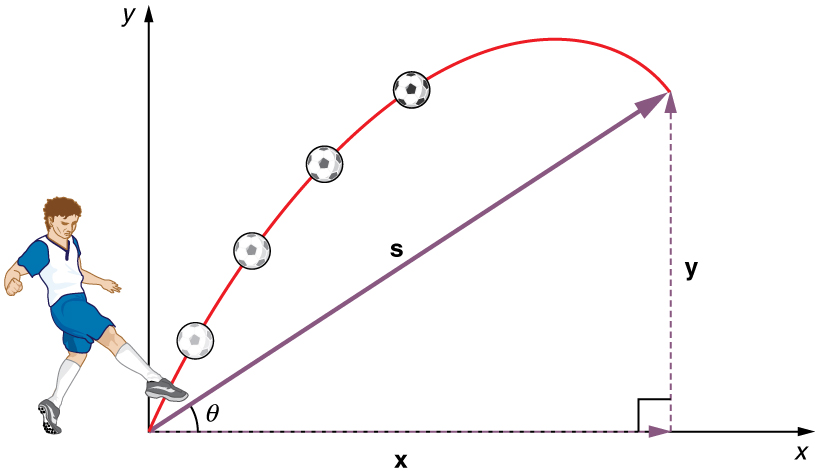
Given these assumptions, the following steps are then used to analyze projectile motion in biomechanics:
Step 1. Resolve or break the motion into horizontal and vertical components along the x- and y-axes. These axes are perpendicular, so [latex]{A}_{x}=A\phantom{\rule{0.25em}{0ex}}\text{cos}\phantom{\rule{0.25em}{0ex}}\theta[/latex] and [latex]{A}_{y}=A\phantom{\rule{0.25em}{0ex}}\text{sin}\phantom{\rule{0.25em}{0ex}}\theta[/latex] are used.
The magnitude of the components of displacement s along these axes are x and y. The magnitudes of the components of the velocity v are:
[latex]{v}_{x}=v \phantom{\rule{0.25em}{0ex}}\text{cos}\phantom{\rule{0.25em}{0ex}}\theta[/latex] and
[latex]{v}_{y}=v \phantom{\rule{0.25em}{0ex}}\text{sin}\phantom{\rule{0.25em}{0ex}}\theta[/latex]
where v is the magnitude of the velocity and [latex]\theta[/latex] is its direction, as shown in Figure 3.35. Initial values are denoted with a subscript i as usual.
Step 2.Treat the motion as two independent one-dimensional motions, one horizontal and the other vertical. The kinematic equations for horizontal and vertical motion take the following forms:
Horizontal Motion (ax = 0)
Step 3. Solve for the unknowns in the two separate motions—one horizontal and one vertical. Note that the only common variable between the motions is time, t. The problem solving procedures here are the same as for one-dimensional kinematics and are illustrated in the solved examples below.
Step 4.Recombine the two motions to find the total displacement s and v. Because the x - and y -motions are perpendicular, we determine these vectors by using the techniques outlined in Vector Addition and Subtraction: Analytical Methods and employing
[latex]A=\sqrt{{A}_{x}^{2}+{A}_{y}^{2}}[/latex]and
[latex]\theta ={\text{tan}}^{-1}\left({A}_{y}/{A}_{x}\right)[/latex] in the following form, where [latex]\theta[/latex] is the direction of the displacement s and [latex]\theta_v[/latex] is the direction of the velocity v:
Total displacement and velocity
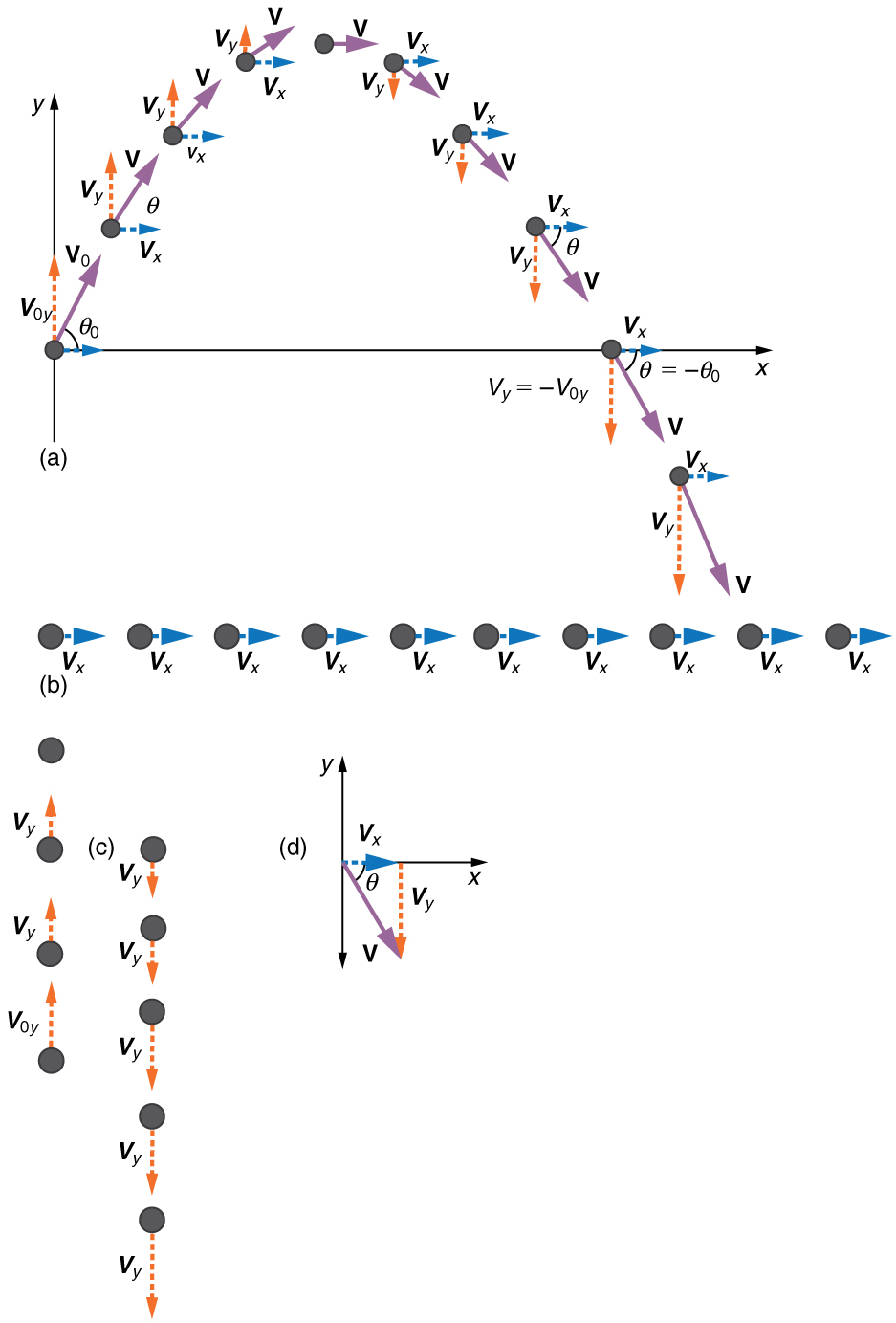
Example: A Fireworks Projectile Explodes High and Away
(a) Calculate the height at which the shell explodes.
(b) How much time passed between the launch of the shell and the explosion?
(c) What is the horizontal displacement of the shell when it explodes?
Strategy
Because air resistance is negligible for the unexploded shell, the analysis method outlined above can be used. The motion can be broken into horizontal and vertical motions in which [latex]{a}_{x}=0[/latex] and [latex]{a}_{y}=–g[/latex]. We can then define [latex]{x}_{i}[/latex] and [latex]{y}_{i}[/latex] to be zero and solve for the desired quantities.
Solution for (a)
By “height” we mean the vertical position [latex]y_f[/latex] above the starting point. The highest point in any trajectory, called the apex, is reached when [latex]v_{fy}=0[/latex]. Since we know the initial and final velocities as well as the initial position, we use the following equation to find [latex]y_f[/latex]:
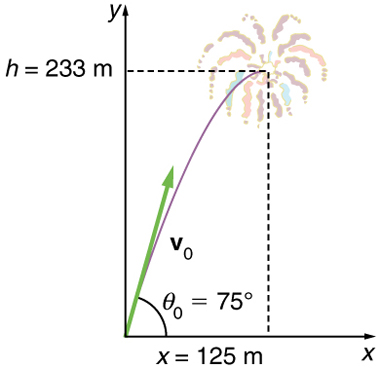
Because [latex]{y}_{i}[/latex] and [latex]{v}_{fy}[/latex] are both zero, the equation simplifies to:
[latex]0={v}_{iy}^{2}-2\text{g}y_f[/latex]
Solving for [latex]y_f[/latex] gives:
[latex]y_f=\frac{v_{iy}^{2}}{2g}\text{.}[/latex]
Now we must find [latex]v_{iy}[/latex], the component of the initial velocity in the y-direction.
It is given by [latex]{v}_{iy}=v \sin \theta[/latex], where v is the initial velocity of 70.0 m/s, and [latex]\theta=75.0º[/latex] is the initial angle. Thus,
[latex]{v}_{iy}={v} \sin \theta = \left(\text{70.0 m/s}\right)\left(\text{sin 75º}\right)=\text{67.6 m/s.}[/latex]
and [latex]y_f[/latex] is:
[latex]y=\frac{\left(67.6 \text{m/s}\right)^{2}}{2\left(9.81 \text{m/s}^{2}\right)}[/latex]
so that
[latex]y_f=\text{233}\text{m.}[/latex]
Discussion for (a)
Note that because up is positive, the initial velocity is positive, as is the maximum height, but the acceleration due to gravity is negative. Note also that the maximum height depends only on the vertical component of the initial velocity, so that any projectile with a 67.6 m/s initial vertical component of velocity will reach a maximum height of 233 m (neglecting air resistance). The numbers in this example are reasonable for large fireworks displays, the shells of which do reach such heights before exploding. In practice, air resistance is not completely negligible, and so the initial velocity would have to be somewhat larger than that given to reach the same height.
Solution for (b)
As in many projectile motion problems, there is more than one way to solve for the time to the highest point (or other variables). In this case, the easiest method is to use [latex]v_{fy}={v}_{iy}+gt[/latex]. Rearranging to solve for t gives:
[latex]t = \frac{\left(v_{fy}-v_{iy}\right)}{g}[/latex]
Thus,
[latex]t = \frac{/left(0 - 67.6/right)}{-9.81}= {6.88 s}[/latex]
Discussion for (b)
This time is also reasonable for large fireworks. When you are able to see the launch of fireworks, you will notice several seconds pass before the shell explodes. (Another way of finding the time is by using [latex]y_f={y}_{i}+{v}_{iy}t-\frac{1}{2}{\text{gt}}^{2}[/latex], and solving the quadratic equation for t)
Solution for (c)
Because air resistance is negligible, [latex]{a}_{x}=0[/latex] and the horizontal velocity is constant, as discussed above. The horizontal displacement is horizontal velocity multiplied by time as given by [latex]x_f={x}_{i}+{v}_{x}t[/latex], where [latex]{x}_{i}[/latex] is equal to zero:
[latex]x_f={v}_{x}t[/latex]
where [latex]{v}_{x}[/latex] is the x-component of the velocity, which is given by [latex]{v}_{x}={v}\phantom{\rule{0.25em}{0ex}}\text{cos}\phantom{\rule{0.25em}{0ex}}{\theta }[/latex] Now,
[latex]{v}_{x}={v}\phantom{\rule{0.25em}{0ex}}\text{cos}\phantom{\rule{0.25em}{0ex}}{\theta }=\left(\text{70}\text{.}0 m/s\text{}\right)\left(\text{cos 75.0º}\right)=\text{18}\text{.}1 m/s.[/latex]
The time t for both motions is the same, and so x is
[latex]x_f=\left(\text{18}\text{.}1 m/s\text{}\right)\left(6\text{.}\text{90 s}\text{}\right)=\text{125 m.}\text{}[/latex]
Discussion for (c)
The horizontal motion is a constant velocity in the absence of air resistance. The horizontal displacement found here could be useful in keeping the fireworks fragments from falling on spectators. Once the shell explodes, air resistance has a major effect because the pieces will be much smaller and lighter, and many fragments will land directly below.
In solving part (a) of the preceding example, the expression we found for [latex]y_f[/latex] is valid for any projectile motion where air resistance is negligible. Call the maximum height [latex]y_f=h[/latex]; then,
[latex]h=\frac{{v}_{iy}^{2}}{2g}\text{.}[/latex]
This equation defines the maximum height of a projectile and depends only on the vertical component of the initial velocity.
Defining a Coordinate System
It is important to set up a coordinate system when analyzing projectile motion. One part of defining the coordinate system is to define an origin for the x and y positions. Often, it is convenient to choose the initial position of the object as the origin such that [latex]{x}_{i}=0[/latex] and [latex]{y}_{i}=0[/latex]. It is also important to define the positive and negative directions in the x and y directions. Typically, we define the positive vertical direction as upwards, and the positive horizontal direction is usually the direction of the object’s motion. When this is the case, the vertical acceleration, g, takes a negative value (since it is directed downwards towards the Earth). However, it is occasionally useful to define the coordinates differently. For example, if you are analyzing the motion of a ball thrown downwards from the top of a cliff, it may make sense to define the positive direction downwards since the motion of the ball is solely in the downwards direction. If this is the case, g takes a positive value.
Example: Calculating Projectile Motion: Unequal launch and landing heights
While in the previous examples the launch and landing heights were assumed to be the same, this next example involves a landing height that is different than the launch height. This is very common in biomechanics - for example, many launched projectiles in sport, such as baseballs, shotput, and even the human body, are launched from a different vertical position relative to where they land. In these cases, the difference in vertical positions between launch and landing will affect the flight time, which in turn influences other variables, such as horizontal displacement and the velocities at impact. The example below uses a simple circumstance in nature, but the application to human motion is the same.
Kilauea in Hawaii is the world’s most continuously active volcano. Very active volcanoes characteristically eject red-hot rocks and lava rather than smoke and ash. Suppose a large rock is ejected from the volcano with a speed of 25.0 m/s and at an angle 35.0º above the horizontal, as shown in Figure 3.37. The rock strikes the side of the volcano at an altitude 20.0 m lower than its starting point.
(a) Calculate the time it takes the rock to follow this path.
(b) What are the magnitude and direction of the rock’s velocity at impact?
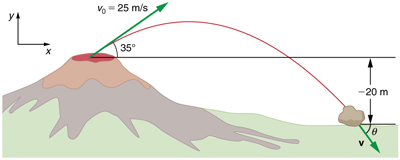
Strategy
Again, resolving this two-dimensional motion into two independent one-dimensional motions will allow us to solve for the desired quantities. The time a projectile is in the air is governed by its vertical motion alone. We will solve for t first. While the rock is rising and falling vertically, the horizontal motion continues at a constant velocity. This example asks for the final velocity. Thus, the vertical and horizontal results will be recombined to obtain v and [latex]\theta_v[/latex] at the final time t determined in the first part of the example.
Solution for (a)
Depending on your familiarity with algebra, there are many different approaches to determining flight time. For example, you could derive flight time directly using the formula [latex]y_f={y}_{i}+{v}_{iy}t-\frac{1}{2}{\text{gt}}^{2}\[/latex], which would eventually be re-rearranged into a quadratic form and solved for t using the quadratic formula.
However, it is usually more common to solve the problem intuitively by considering the vertical motion of the rock on the way up and the way down separately. That is, the vertical motion on the way up can be solved in the same manner as above. Then for the way down we will need to take into account the extra 20m the projectile falls below the launch height. In other words, the time the projectile takes to fall from peak height to its landing spot will NOT be the same as the time it takes to travel from its launch spot to peak height.
While this approach takes a few extra steps, it also allows us to solve for other variables of interest, which may be useful later on.
i) First, let's resolve v into it's components [latex]v_{iy}[/latex] and [latex]v_{ix}[/latex], using [latex]{v}_{iy}={v}\text{sin}\theta[/latex] and [latex]{v}_{iy}={v}\text{cos}\theta[/latex]. Substituting the known values yields:
[latex]v_{iy} = \text{25}\text{.}\text{0 m/s }\text{(sin 35.0º)}= \text{14}\text{.}\text{3 m/s}[/latex]
[latex]v_ix = \text{25}\text{.}\text{0 m/s }\text{(cos 35.0º)}= \text{20}\text{.}\text{5 m/s}[/latex]
Quick check: these numbers seem to make sense, since the launch angle is less than 45º we would expect the horizontal component to be greater than the vertical component. We could even confirm our calculations by using the components to calculate the magnitude of v using the Pythagorean Theorem
ii) Next, we can solve for peak height using [latex]v_{iy}[/latex]. Peak height will be useful to determine both the time up and time down. To solve for peak height we can use the equation from above, [latex]h=\frac{{v}_{iy}^{2}}{2g}\text{.}[/latex]:
[latex]h = \frac {v_{iy}^2}{2g} = frac{\left(14.3^2\right)}{2*9.81\text{m/s}^2} = 10.4 \text{m}[/latex]
iii) Finally, we can use this information to solve for total flight time, using:
[latex]t_{flight} = t_{up} + t_{down}[/latex].
To solve for both [latex]t_{up}[/latex] and [latex]t_{down}[/latex], we can use:
[latex]y_f={y}_{i}+{v}_{iy}t-\frac{1}{2}{\mathrm{gt}}^{2}[/latex].
Knowing that the velocity of the projectile will be 0 m/s at peak height and that the vertical motion of a projectile is identical on the way up and way down (see previous section), we can treat this as a simple 'dropped projectile' problem, where [latex]v_{iy} = 0 \text{m/s}[/latex] and [latex]y_i = 0 \text{m}[/latex], which simplifies the equation to:
[latex]y_f = \frac{1}{2}{\mathrm{gt}}^{2}[/latex],
and solving for t
[latex]t = \sqrt{frac{2*y_f}{g}}[/latex]
For [latex]t_{up}[/latex], [latex]y_f = -10.4 \text{m}[/latex] (or 10.4 m below peak height), so
[latex]t_{up} = \sqrt{frac{2*-10.4}{-9.81}} = 1.46 \text {sec}[/latex],
and for [latex]t_{down}[/latex], [latex]y_f = -30.4 \text{m}[/latex] (or 10.4 m + 20.0 m below peak height)
[latex]t_{up} = \sqrt{frac{2*-30.4}{-9.81}} = 2.49 \text {sec}[/latex]
And so [latex]t_{flight}[/latex] can be solved by:
[latex]t_{flight} = t_{up} + t_{down} = 1.46 + 2.49 = 3.95 \text{sec}[/latex]
Discussion for (a)
The time for projectile motion is completely determined by the vertical motion. So any projectile that has an initial vertical velocity of 14.3 m/s and lands 20.0 m below its starting altitude will spend 3.95 s in the air. Additionally, there are many different ways to arrive at this answer.
Solution for (b)
From the information now in hand, we can find the final horizontal and vertical velocities [latex]{v}_{xf}[/latex] and [latex]{v}_{yf}[/latex] and combine them to find the total velocity v and the angle [latex]\theta_f[/latex] it makes with the horizontal.
Of course, [latex]{v}_{x}[/latex] is constant and we've already solved for [latex]v_{ix}[/latex], so [latex]v_x = v_{ix} = v_{fx} = 20.5 \text{m/s}[/latex]
Perhaps the most intuitive way to solve the final vertical velocity is to use [latex]t_{down} = 2.49 \text{sec}[/latex] and the formula [latex]v_{fy} = v_{iy} + gt[/latex], where [latex]v_{iy} = 0 [/latex}. Therefore:
[latex] v_{fy} = 0 + \left(-9.81\right)*2.49 = -24.4 \text {m/s}[/latex]
note: we could have also solved from the perspective of the initial launch, where [latex]v_{iy} = 14.3 \text{m/s}[/latex] and then [latex]t = 3.95[/latex], which yields the same answer, -24.4 m/s.
Lastly, to find the magnitude of the final velocity v we combine its perpendicular components, using the following equation:
[latex]v=\sqrt{{v}_{xf}^{2}+{v}_{yf}^{2}}=\sqrt{\left(20.5 \text{m/s}\right)^{2}+\left(-24.4 \text{m/s}\right)^{2}}[/latex]
which gives
[latex]v=31.9 \text{m/s}[/latex]
The direction [latex]\theta_{v}[/latex] is found from the equation:
[latex]\theta_{v}={\text{tan}}^{-1}\left({v}_{y}/{v}_{x}\right)[/latex]
so that
[latex]\theta_{v}={\text{tan}}^{-1}\left(-\text{24}\text{.}5/\text{20}\text{.}5\right)={\text{tan}}^{-1}\left(-1\text{.}\text{19}\right)\text{.}[/latex]
Thus,
[latex]\theta_{v}=-\text{50}\text{.}1º\text{.}[/latex]
Discussion for (b)
The negative angle means that the velocity is 50.1º below the horizontal. This result is consistent with the fact that the final vertical velocity is negative and hence downward—as you would expect because the final altitude is 20.0 m lower than the initial altitude. (See Figure 3.37)
Initial Conditions and Launched Projectiles in Sport
One of the most important things illustrated by projectile motion is that vertical and horizontal motions are independent of each other. Galileo was the first person to fully comprehend this characteristic. He used it to predict the range of a projectile. On level ground, we define range to be the horizontal distance R traveled by a projectile. Galileo and many others were interested in the range of projectiles primarily for military purposes—such as aiming cannons. However, investigating the range of projectiles can shed light on other interesting phenomena, such as the optimal angles or velocities to launch projectiles in sport.
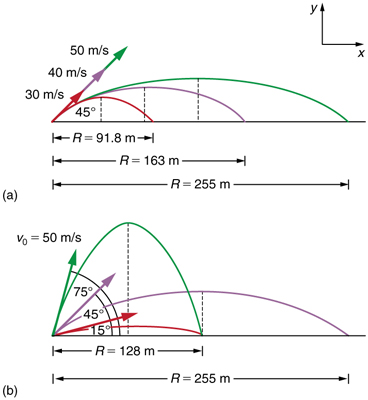
How does the initial velocity of a projectile affect its range? Obviously, the greater the initial speed v, the greater the range, as shown in Figure 3.38(a). This occurs in many aspects of sport and recreation. For example, increasing the velocity that a golf ball or baseball leaves the implement will result in a great range - longer drives or more home runs - everything else being equal. Similarly, a greater run-up speed in the long jump will result in a longer jump. That (partially) explains why so many resources, whether technological, financial or even time (training) are spent trying to increase launch velocities in sport. And also why many sport regulating bodies impose limits on the construction of sports implements in an attempt to ensure fairness and/or consistency.
The initial angle [latex]\theta[/latex] also has a dramatic effect on the range, as illustrated in Figure 3.38(b). For a fixed initial speed, and where the launch and landing height are the same, the maximum range is obtained with [latex]\theta=\text{45º}[/latex]. This is true only for conditions neglecting air resistance. If air resistance is considered, the maximum angle is usually a bit lower at approximately 38º. Interestingly, for every initial angle except 45º, there are two angles that give the same range—the sum of those angles is 90º. The range also depends on the value of the acceleration of gravity g. The lunar astronaut Alan Shepherd was able to drive a golf ball a great distance on the Moon because gravity is weaker there. The range R of a projectile on level ground for which air resistance is negligible is given by
[latex]R=\frac{{v}_{i}^{2}\text{sin}2 \theta}{g}[/latex]
where [latex]{v}_{i}[/latex] is the initial speed and [latex]\theta[/latex] is the initial angle relative to the horizontal.
Lastly, in the case of human motion, the assumptions above about optimal angles of projection also assume that the force generated by the human body is constant. That is, that the same amount of force is able to be generated regardless of the angle of projection (as we'll learn in later chapters, it is the force generated by the body that ultimately produces the velocity of the launched projectile). However, in order to change the angle of projection we often have to alter the orientation of our limbs - and as you should remember from anatomy class, changing the direction or orientation of our arms and legs often changes which muscle groups are active. Therefore, in biomechanics we must often integrate knowledge from anatomy and physiology in order to determine the real world application of the underlying physics.
PhET Explorations: Projectile Motion
Learn about projectile motion by firing various objects. Set the angle, initial speed, and mass. Add air resistance. Explore the effects of projectile motion and optimize initial conditions to try to hit a target.
https://phet.colorado.edu/sims/html/projectile-motion/latest/projectile-motion_en.html

